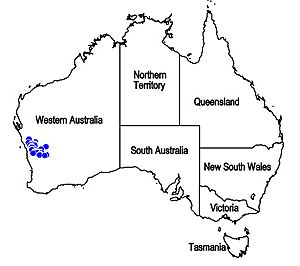Dicrastylis soliparma facts for kids
Quick facts for kids Dicrastylis soliparma |
|
|---|---|
| Scientific classification | |
 |
Dicrastylis soliparma is a species of plant within the genus, Dicrastylis, in the family Lamiaceae. It is endemic to Western Australia.
Description
Dicrastylis soliparma is spreading shrub, growing from 30 cm to 1.5 m high, on sandy soils, on sandplains and road verges. Its stems are roughly circular in cross section, with a dense white or rusty coloured covering when young, and have no peltate scales. The opposite and entire leaves are 7-25 mm long by 3.5-7 mm wide, and have branched (dendritic) hairs, and a blistered, puckered surface. There are no bracteoles, but there are bracts which are 1-2.5 mm long. The flower stalks are 2-4.5 mm long, and have both dendritic and peltate scale hairs. The calyx has five lobes (1-2 mm long), and is covered in dendritic hairs, and the white or cream corolla is 3-6.2 mm long, with no dots or stripes in its throat. There are five stamens. Flowers may be seen from October to December.
It is found in Beard's Eremaean and South-West Provinces.
Taxonomy
It was first described by Barbara Rye and Malcolm Trudgen in 1998 as Dicrastylis soliparma. There are no synonyms.

